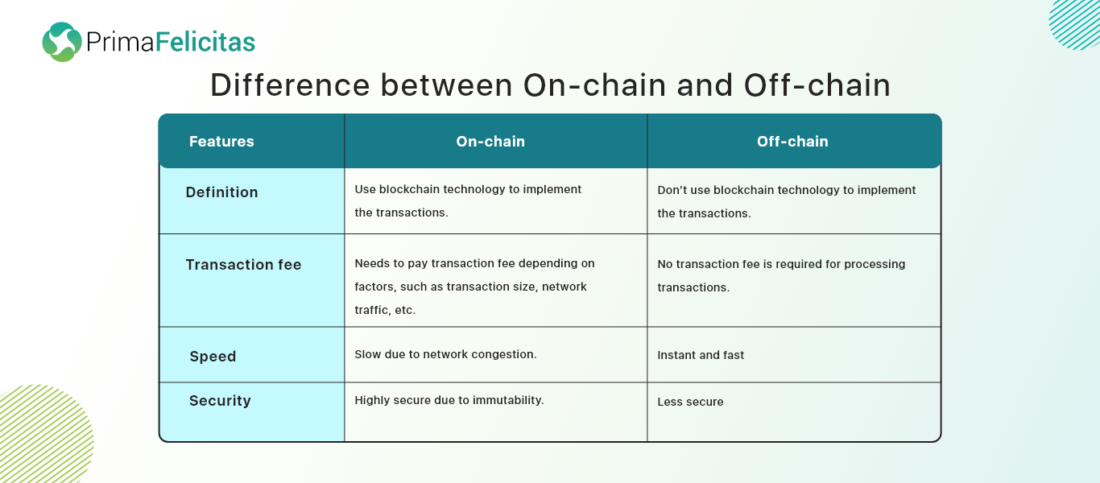What is a dApp?
Decentralized applications (dApps) refer to software applications that execute on peer-to-peer distributed networks by combining smart contracts with a frontend user interface. On the blockchain, such as Ethereum, smart contracts reside transparently with open accessibility like open APIs. dApps have many underlying features, such as open source, turning complete, isolated, and deterministic.
As dApps are decentralized, they are much more secure and don’t suffer downtime compared to traditional applications. This is because they don’t use any centralized physical device for functioning, which is usually the target of hackers. They are developed for several purposes, such as gaming, finance, medicine, and social media. However, the only difference between dApps and traditional applications is the backend, where dApps use blockchain networks
What is the On-chain layer in dApps?
The On-chain layer is responsible for the transactions that execute on the blockchain. These transactions are stored on the decentralized ledger and are visible to anyone with a copy of the ledger. The entire blockchain network is updated each time an On-chain transaction is performed.
At a time when the number of transactions is low, On-chain transactions occur quickly. However, when the number of transactions is high, the network can be slow due to congestion.
What is the Off-chain layer in dApps?
The Off-chain layer is the external layer responsible for interacting with the users outside the blockchain. dApp requires synchronizing both the layers (On-chain layer and Off-chain layer) to perform requested tasks. Otherwise, the unsynchronized information can mislead users and cause undesirable consequences, such as loss of transaction fees. Also, transactions sent to the blockchain aren’t guaranteed to be executed and could even be reverse-executed due to chain reorganization.
Advantages of On-chain dApps:
On-chain dApps can provide multiple advantages, whether they are utilizing public blockchain or private blockchain. The following are the benefits of On-chain dApps:
- Irreversible transactions: The transactions occur directly on the blockchain, which makes them irreversible once it is performed.
- Highly secure: The transactions are highly secure as they are based on principles of cryptography and a level of encryption that protects each transaction.
- Transaction Validation: Each transaction On-chain is validated, as blockchain follows the consensus algorithm that ensures trust in transactions.
- Immutable: The transactions On-chain are immutable, which means they can’t be changed or deleted once recorded on the blockchain.
Are there any issues in On-chain dApps?
As Web3 is still evolving, dApps have not completely developed to become truly decentralized and on-chain. This is due to the following reasons:
- Low speed: Blockchain’s transaction speed is the major concern that varies because of several factors, such as block size, block time, transaction fees, and network traffic.
- High transaction fees: The transaction fee of On-chain transactions is usually high as it depends upon the capacity of the transactions.
Because of the blockchain limitations, many dApp developers are not fully on-chain as developers prefer certain functions to be incorporated by third-party providers off-chain.
Can Off-chain resolve On-chain dApps issues?
Yes, the Off-chain layer can resolve the above issue to some extent. For example, in off-chain, the transactions can be executed instantly without any time lag as they are not performed on Blockchain. These transactions don’t require any validation, which makes them faster. The cost linked with off-chain transactions is also minor.
There are several disadvantages of Off-chain as it is usually centralized. For example, the central authority has access to data that affects privacy. The central authority has the right to deny access to the user, destroy their data, etc. Further, there is no guarantee that the information will be stored forever as it is not stored on the blockchain.
However, to balance the performance, security, and cost of the dApp, it can be developed with both layers. For example, the On-chain layer performs transactions on the blockchain, and the Off-chain layer interacts with the user. Hence, the significance of On-chain dApps completely depends upon the use case for which it is developed. On-chain transactions are ideal for situations where the user wants high security and immutability.
Difference between On-chain and Off-chain:


Conclusion:
Since the emergence of Ethereum, dApps have become very popular and significant. The number of use cases of dApps is increasing every day, increasing the confusion about whether to create an On-chain dApp or an Off-chain dApp. From the above perspective, we can conclude that the choice between On-chain and Off-chain depends entirely upon the use case for which the dApp is to be created. Combining both layers as per the requirements can be beneficial in all aspects, such as cost, security, and speed. Hence, dApp 100% On-chain might not be beneficial and effective.
Looking for help here?
Connect with Our Expert for a detailed discussion
Post Views: 30
- SEO Powered Content & PR Distribution. Get Amplified Today.
- PlatoAiStream. Web3 Data Intelligence. Knowledge Amplified. Access Here.
- Minting the Future w Adryenn Ashley. Access Here.
- Buy and Sell Shares in PRE-IPO Companies with PREIPO®. Access Here.
- Source: https://www.primafelicitas.com/Insights/dapps-100-on-chain-is-it-beneficial-or-not/?utm_source=rss&utm_medium=rss&utm_campaign=dapps-100-on-chain-is-it-beneficial-or-not



